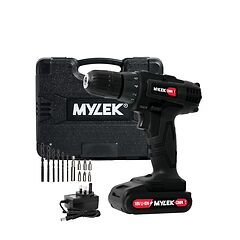
September 8th, 2020 by
When purchasing a power tool, it’s all too easy to assume that the more power it has, the better it will be. But is this necessarily the case? The best rule of thumb for buying an item such as a drill is to buy the model that is best suited to the type of job you need it for. Function and purpose are key.
Drills commonly come in 21V and 18V models, but which is better?
The truth is that ‘better’ is a subjective term because it depends on several factors. This includes what you intend to use it for, your budget, and your own expertise and experience. Let’s take a look at both options to determine which is the best one for you.
21V Drills
As you might guess, 21V is more powerful than 18V. But what does that power actually do for you when you’re drilling? Well, the power can be used in one of two areas – torque and speed. Torque refers to the force the drill uses to turn an object and is measured in N.m (Newtonmeters). Speed refers to how fast the drill can turn an object and is measured in RPM (revs per minute). A 21V drill gives you more of both, so it lets you work more effectively on a broader range of materials.
As you may know, high torque is better for working on harder materials, whereas high speed is better for softer materials. With a 21V drill, you have a bit more flexibility in both areas.
MYLEK 21V Cordless Drill
Price: £49.99
Buy Now
18V Drills
So, with all of that said, why would you want an 18V drill? Well, less power does not necessarily mean ‘not as good’! For a start, 18V drills tend to be cheaper than their more powerful counterparts, so they might offer you more value for money if you only need them for the occasional home DIY job. They also tend to be lighter and smaller so can be much easier to use, especially if you’re not an experienced DIYer. If you don’t spend a lot of time drilling into hardwood, you probably don’t need an all-singing all-dancing 21V cordless drill.
MYLEK Black 18V Li-ion Cordless Drill 2 Speed MYCBMC
Price: £43.00
Buy Now
Consider your needs
As stated at the top of this piece, ‘better’ is subjective. If you don’t need a drill for heavy-duty tasks, an 18V model should be more than powerful for your needs, plus it’s going to be easier to use and cheaper. If you have some tough jobs to work on, and your drill will get regular use, go straight for a 21V drill as you will probably find that 18V just doesn’t cut it and would be a false economy if you then have to upgrade to a more powerful model.
What About 20V Drills?
One thing many people get confused about is where 20V drills fit into all this. 20V drills are not, as you might expect, the middle child that sits between the 18V and 21V models. 20V drills are, in fact, exactly the same as 18V drills!
Don’t panic, though – this isn’t some shady false advertising trick! It’s simply a quirk of how batteries are measured. Batteries are made up of 5 individual cells that are wired together. Each one has two voltage ratings – nominal and maximum. This is because the amount of voltage discharged by the battery fluctuates slightly as you use the drill (it produces more when fully charged). The nominal voltage of these batteries is 18V, and the maximum is 20V. Some batteries are measured using their nominal voltage, and others are measured using their maximum voltage, but both are otherwise exactly the same!
Comments
Leave a reply
Your e-mail address will not be published. All fields are required



